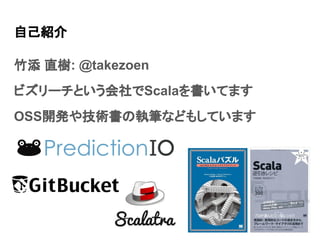Ad
Non-Functional Programming in Scala
- 1. Non-Functional Programming in Scala Naoki Takezoe @takezoen BizReach, Inc
- 5. 突き当たった壁
- 6. 関数型プログラミング
- 20. 方針 そもそもScalaは副作用のある手続き型プログラミング言語であ り、モナドを意識せずに使えるように設計されている Scalaの便利な機能を使いつつ、関数型プログラミングに寄せす ぎないようにする
- 21. 使うべきか?使わないべきか? ● var、while ● mutableコレクション ● return ● 例外 ● null ● Option.get ● for内包表記 ● 型クラス
- 22. 考えてみよう!!
- 23. var、while
- 24. var、while ループ処理などでフラグやアキュムレータなどに使いがち takeWhileやfoldLeftなどで代用可能だが取っつきづらい var line = reader.readLine() while(line != null) { ... line = reader.readLine() }
- 25. var、while ループ処理などでフラグやアキュムレータなどに使いがち takeWhileやfoldLeftなどで代用可能だが取っつきづらい var line = reader.readLine() while(line != null) { ... line = reader.readLine() }
- 27. mutableコレクション
- 28. mutableコレクション ループしながら詰め替えるような処理で使いがち val list = ... val map = mutable.Map("some" -> 0, "none" -> 0) list.foreach { x => if (x.nonEmpty) { map.put("some", map("some") + 1) } else { map.put("none", map("none") + 1) } }
- 29. mutableコレクション ループしながら詰め替えるような処理で使いがち val list = ... val map = mutable.Map("some" -> 0, "none" -> 0) list.foreach { x => if (x.nonEmpty) { map.put("some", map("some") + 1) } else { map.put("none", map("none") + 1) } }
- 30. mutableコレクション メソッド内での利用であれば許容する 戻り値として返す際にimmutableなコレクションに変換する 使わなくても済むものはimmutableなコレクションを使うように啓 蒙していく val map = list.groupBy(_.nonEmpty) .map { case (nonEmpty, values) => if(nonEmpty) "some" -> values.size else "none" -> values.size }
- 31. return
- 32. return Ealry returnやループ処理中からのreturnなどが使われがち def hello(names: Seq[String]): String = { if(name.isEmpty) return "" ... } 戻り値の型を明記しないといけなくなる コンパイル後に例外(ControlThrowable)で実現されるケースが ある
- 33. return Ealry returnやループ処理中からのreturnなどが使われがち def hello(names: Seq[String]): String = { if(name.isEmpty) return "" ... } 戻り値の型を明記しないといけなくなる コンパイル後に例外(ControlThrowable)で実現されるケースが ある
- 34. return 実際に問題になるケースは少ないので許容してもよいのでは そもそも例外をThrowableでキャッチしない try { ... } catch { case NonFatal(t) => ... }
- 35. 例外
- 36. 例外 エラーを戻り値で返すか?Eitherなどで返すか? def findUser(): Either[Exception, User] = { try { val user: User = ... Right(user) } catch { case e: Exception => Left(e) } }
- 37. 例外 エラーを戻り値で返すか?Eitherなどで返すか? def findUser(): Either[Exception, User] = { try { val user: User = ... Right(user) } catch { case e: Exception => Left(e) } }
- 39. null
- 40. null
- 42. Option.get
- 43. Option.get 値が必ず入っているはずだと直接getしがち Noneチェックしてからgetしがち val opt: Option[String] = ... if(opt.isDefined){ val str = opt.get ... }
- 44. Option.get 値が必ず入っているはずだと直接getしがち Noneチェックしてからgetしがち val opt: Option[String] = ... if(opt.isDefined){ val str = opt.get ... }
- 46. for内包表記
- 47. for内包表記 モナモナするときに使う for { project <- findProject(projectId) user <- findUser(userId) } yield { registerComment(project, user, comment) }
- 48. for内包表記 モナモナするときに使う for { project <- findProject(projectId) user <- findUser(userId) } yield { registerComment(project, user, comment) }
- 50. 型クラス
- 51. 型クラス implicitの使い方の一種 implicit val userInfoReads = Json.reads[UserInfoInfo] r.body.validate[UserInfo].fold( error => ..., form => ... ) sealed trait JsValue extends JsReadable { def validate[A](implicit rds: Reads[A]): JsResult[A] }
- 52. 型クラス implicitの使い方の一種 implicit val userInfoReads = Json.reads[UserInfoInfo] r.body.validate[UserInfo].fold( error => ..., form => ... ) sealed trait JsValue extends JsReadable { def validate[A](implicit rds: Reads[A]): JsResult[A] }
- 54. 結果 ● var、while ● mutableコレクション ● return ● 例外 ● null ● Option.get ● for内包表記 ● 型クラス
- 57. ご静聴ありがとうございました































![return
Ealry returnやループ処理中からのreturnなどが使われがち
def hello(names: Seq[String]): String = {
if(name.isEmpty) return ""
...
}
戻り値の型を明記しないといけなくなる
コンパイル後に例外(ControlThrowable)で実現されるケースが
ある](https://image.slidesharecdn.com/non-functionalprogramminginscala-170909165749/85/Non-Functional-Programming-in-Scala-32-320.jpg)
![return
Ealry returnやループ処理中からのreturnなどが使われがち
def hello(names: Seq[String]): String = {
if(name.isEmpty) return ""
...
}
戻り値の型を明記しないといけなくなる
コンパイル後に例外(ControlThrowable)で実現されるケースが
ある](https://image.slidesharecdn.com/non-functionalprogramminginscala-170909165749/85/Non-Functional-Programming-in-Scala-33-320.jpg)


![例外
エラーを戻り値で返すか?Eitherなどで返すか?
def findUser(): Either[Exception, User] = {
try {
val user: User = ...
Right(user)
} catch {
case e: Exception => Left(e)
}
}](https://image.slidesharecdn.com/non-functionalprogramminginscala-170909165749/85/Non-Functional-Programming-in-Scala-36-320.jpg)
![例外
エラーを戻り値で返すか?Eitherなどで返すか?
def findUser(): Either[Exception, User] = {
try {
val user: User = ...
Right(user)
} catch {
case e: Exception => Left(e)
}
}](https://image.slidesharecdn.com/non-functionalprogramminginscala-170909165749/85/Non-Functional-Programming-in-Scala-37-320.jpg)





![Option.get
値が必ず入っているはずだと直接getしがち
Noneチェックしてからgetしがち
val opt: Option[String] = ...
if(opt.isDefined){
val str = opt.get
...
}](https://image.slidesharecdn.com/non-functionalprogramminginscala-170909165749/85/Non-Functional-Programming-in-Scala-43-320.jpg)
![Option.get
値が必ず入っているはずだと直接getしがち
Noneチェックしてからgetしがち
val opt: Option[String] = ...
if(opt.isDefined){
val str = opt.get
...
}](https://image.slidesharecdn.com/non-functionalprogramminginscala-170909165749/85/Non-Functional-Programming-in-Scala-44-320.jpg)






![型クラス
implicitの使い方の一種
implicit val userInfoReads = Json.reads[UserInfoInfo]
r.body.validate[UserInfo].fold(
error => ...,
form => ...
)
sealed trait JsValue extends JsReadable {
def validate[A](implicit rds: Reads[A]): JsResult[A]
}](https://image.slidesharecdn.com/non-functionalprogramminginscala-170909165749/85/Non-Functional-Programming-in-Scala-51-320.jpg)
![型クラス
implicitの使い方の一種
implicit val userInfoReads = Json.reads[UserInfoInfo]
r.body.validate[UserInfo].fold(
error => ...,
form => ...
)
sealed trait JsValue extends JsReadable {
def validate[A](implicit rds: Reads[A]): JsResult[A]
}](https://image.slidesharecdn.com/non-functionalprogramminginscala-170909165749/85/Non-Functional-Programming-in-Scala-52-320.jpg)





![[事例紹介]Scalaで物流倉庫システム作ったよ](https://cdn.slidesharecdn.com/ss_thumbnails/scala170908-170919052415-thumbnail.jpg?width=560&fit=bounds)





















![[Scalamatsuri2016]あ、社内コミュニティ](https://cdn.slidesharecdn.com/ss_thumbnails/scalamatsuriltnosato-160131091336-thumbnail.jpg?width=560&fit=bounds)






















![Scalaで萌える関数型プログラミング[エッセンシャル版]](https://cdn.slidesharecdn.com/ss_thumbnails/scalalt-110709014759-phpapp02-thumbnail.jpg?width=560&fit=bounds)



























